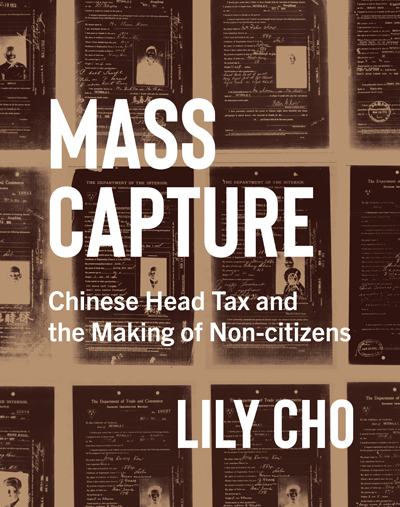
Mass Capture: Chinese Head Tax and the Making of Non-citizens
Review By Alice Louise Gorton
March 21, 2023
BC Studies no. 217 Spring 2023 | p. 118-119
Mass Capture: Chinese Head Tax and the Making of Non-citizens, by York University English professor Lily Cho, tells the story of a unique archive and the people documented within it. Using the roughly 41,000 Chinese Immigration 9 (CI9) documents that the Canadian state collected to monitor the outbound movements of migrants between 1885-1953, she argues that the head tax, with its accompanying bureaucratic machinery, functioned as a “form of surveillance” that created non-citizens through a process of “mass capture” (8). Crucial to this argument is a definition of non-citizenship that moves beyond its seemingly self-evident connotations. Cho defines the people photographed in the CI 9s as non-citizens because they were not and indeed had little hope of becoming citizens from 1885 to 1947, when the repeal of the Chinese Immigration Act ended a decades-long campaign to tax and, later, outright exclude Chinese migrants from Canada. Yet she extends the definition, arguing that the “non-citizen” was never a static figure constituted only by its opposite, the citizen; instead, the head tax produced the non-citizen through a double form of mass capture. Initially deployed by legal scholars to denote large-scale corporate or governmental data collection, here the term specifies how surveillance operated on both the bodily and regulatory levels. Applicants were required to file for a CI 9, which from 1910 affixed an identifying photograph, in order to travel outside of Canada. The certificate asked variously for names and nicknames, date of initial entry at a Canadian port, place of birth, present residence, occupation, as well as “facial marks or other peculiarities” and so on.
For Cho, the photographs and details recorded in the CI 9s “demand forms of legibility, and audibility, that far exceed the limits of the certificates themselves” (13). This sentence is a way to understand the book’s central task. It is a meditation on the construction of non-citizens within a tradition of “repressive photography,” but it is also an interpretive history that invokes an extensive theoretical apparatus to position the CI 9s as sites of refusal, agency, and kinship (11). In chapter one, Cho explores how corporeal and documentary forms of capture co-exist at the heart of the CI 9s, showing the certificates to be a repetitive technology of discrimination that functioned both through the state and the archive. Chapter two turns to how this technology was prone to failure, emphasizing the “persistent unknowability” of the CI 9s’ subjects, who often remained elusive– a testament, she says, to migrants’ refusal to be identified and denied dignity (53; 106). Through an analysis of the CI 9s as tools of family separation, chapter three brings out kinship and its rupture within what Cho calls an exceedingly “lonely” and male-centered archive. The fourth chapter highlights how the “grammars” and tensions of language in the forms themselves signal a “refusal to be refused” (197), while chapter five contains a discussion of “anticipation,” a speculative reading of the “potentiality” of citizenship in the documents.
Cho relies on a series of interdisciplinary frameworks throughout, but there is tension between the documentary evidence and the theoretical edifice. A lengthy discussion of the citizenship status of the ancient Greek Teucer, for instance, proves much less satisfying than a brief glimpse of four unidentified Chinese migrants’ resistance on the SS Teucer in 1917 (49). To take another example, Cho’s discussion of anticipation and affect in chapter five has almost nothing to say about the CI 9s or even Chinese immigration at all. Still, Cho succeeds when she focuses on the documents, excavating the stories so tantalizingly contained within them and the implications of their storage and memory. And as an invitation to reflect on the relationship between photography, state racism, citizenship, and the archive, the book, as well as its accompanying online resources, provides an arresting visual counterpart to existing studies of the period that will be an invaluable resource for research and teaching.[1]
References
[1] “Mass Capture: Chinese Head Tax and the Making of Non-Citizens,” https://masscapture.ca/; for an open access edition of the book, see https://oer.pressbooks.pub/masscapture/front-matter/mass-capture/; and for a good example of the existing literature, Lisa Mar, Brokering Belonging: Chinese in Canada’s Exclusion Era, 1885-1945 (Oxford: Oxford University Press, 2010).
Publication Information
Cho, Lily. Mass Capture: Chinese Head Tax and the Making of Non-citizens. Montreal and Kingston: McGill-Queen’s University Press, 2021. 272 pp. $39.95 paper.
